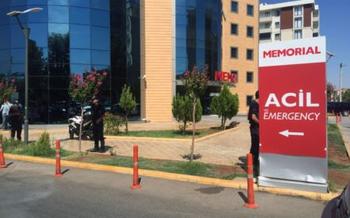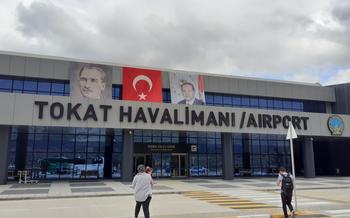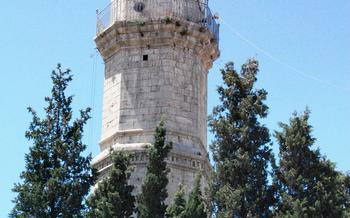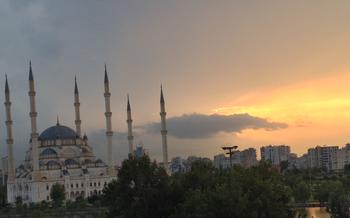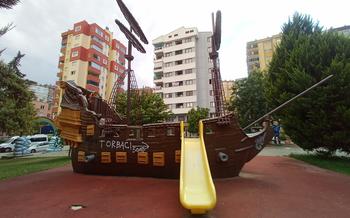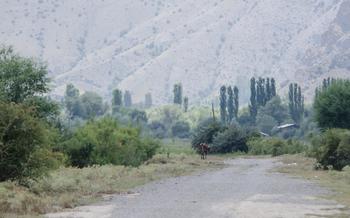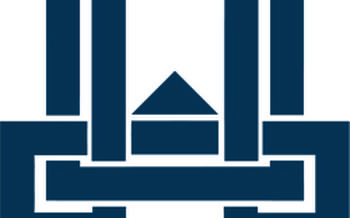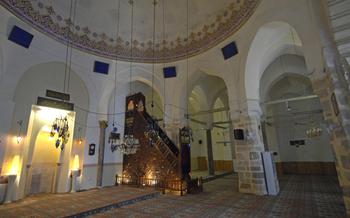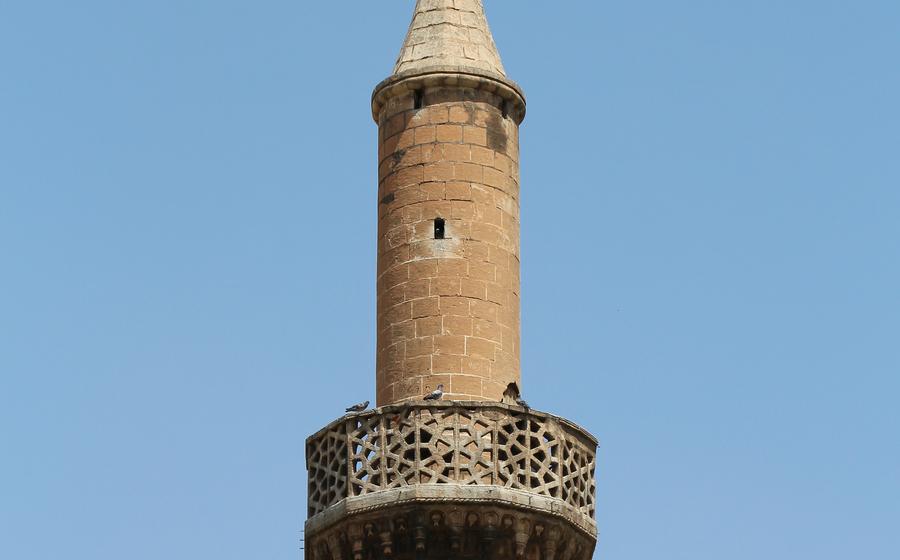
Rızvaniye Mosque
- History of the Rızvaniye Mosque
- Architectural Features
- Interior Decorations:
- Religious Significance:
- Cultural Heritage
- Prayer Hall
- Minaret
- Dome
- Prayer Times and Services
- Nearby Attractions
- Festivals and Events
- Getting There
- Photography and Videography
- Insider Tip:
History of the Rızvaniye Mosque
The Rızvaniye Mosque, a majestic architectural marvel, stands as a testament to the rich history and religious heritage of Şanlıurfa, Turkey. Its origins date back to the 13th century, during the reign of the Artuqid dynasty, when it was commissioned by the governor of the region, Rızvanoğlu Abdullah. The mosque's construction reflects the architectural influences of the Seljuk and Mamluk periods, blending elements from both to create a unique masterpiece. Over the centuries, the mosque has undergone several renovations and expansions, each contributing to its grandeur and significance. Its historical value and architectural beauty have made it a cherished landmark, deeply revered by the local Muslim community and a must-visit destination for travelers seeking a glimpse into Turkey's Islamic heritage.
-
Architectural Influences and Design: The Rızvaniye Mosque showcases a harmonious blend of architectural styles, drawing inspiration from the Seljuk and Mamluk periods. The Seljuk influence is evident in the pointed arches, intricate carvings, and geometric patterns that adorn the mosque's exterior and interior. The Mamluk influence, on the other hand, is seen in the tall, slender minaret and the use of stone in the construction, contributing to the mosque's overall grandeur.
-
Importance of the Mosque in the Region: The Rızvaniye Mosque holds immense religious and historical significance in the region. It serves as a central place of worship for the local Muslim community, facilitating daily prayers and congregational gatherings. Additionally, the mosque has played a crucial role in preserving and promoting Islamic teachings and traditions, acting as a hub for religious education and spiritual guidance. Its historical value and architectural beauty have made it a symbol of pride and heritage for the people of Şanlıurfa.
-
Historical Events and Stories Associated with the Mosque: Over the centuries, the Rızvaniye Mosque has witnessed numerous historical events and accumulated a rich tapestry of stories. It is said that the mosque was once visited by the famous Islamic scholar Ibn Battuta, who marveled at its architectural splendor and the devoutness of the local community. Another legend tells of a miraculous healing that occurred within the mosque's walls, further solidifying its reputation as a sacred and blessed space.
Architectural Features
The Rızvaniye Mosque, a prime example of Ottoman architecture, boasts a captivating blend of Islamic and Seljuk influences. Its exterior facade showcases intricate stone carvings, geometric patterns, and elegant calligraphy, reflecting the artistry of the period. The mosque's central dome, supported by four massive pillars, dominates the skyline, symbolizing the grandeur of Islamic architecture.
Inside, visitors are greeted by a spacious prayer hall adorned with marble columns, arched doorways, and vaulted ceilings. The mihrab, the niche indicating the qibla, is meticulously crafted with intricate tilework, while the minbar (pulpit) features exquisite carvings and calligraphy. The harmonious interplay of light and shadow through the stained glass windows creates a serene and spiritual atmosphere within the mosque.
Interior Decorations:
The Rızvaniye Mosque boasts exquisite interior decorations that reflect the artistry and craftsmanship of the Ottoman era. The walls are adorned with intricate calligraphy, featuring verses from the Quran and the names of Allah and the Prophet Muhammad. The calligraphy is executed in various styles, including Thuluth, Kufic, and Naskh, adding to the visual appeal of the mosque.
The decorations also include colorful tiles, mosaics, and stained glass windows. The tiles feature floral and geometric patterns, while the mosaics depict scenes from Islamic history and mythology. The stained glass windows filter the sunlight, creating a warm and ethereal ambiance inside the mosque.
The mihrab, the niche in the wall indicating the qibla (direction of prayer), is a masterpiece of Islamic art. It is intricately carved with verses from the Quran and features a beautiful mosaic depicting the Kaaba in Mecca. The minbar, the pulpit from which the imam delivers the sermon, is also elaborately decorated with carvings and inlaid with mother-of-pearl.
The overall effect of the interior decorations is one of awe and inspiration. The mosque's interior is a testament to the skill and devotion of the artisans who created it, and it serves to enhance the spiritual experience of the worshippers.
Religious Significance:
The Rızvaniye Mosque holds immense religious significance as a center of worship for the local Muslim community. Throughout history, it has been a place where the faithful gather to perform their daily prayers and seek spiritual guidance. The mosque serves as a focal point for religious ceremonies and practices, including congregational prayers, Quranic recitations, and Islamic teachings.
The mosque's spiritual significance is deeply rooted in its symbolic representation of Islamic beliefs and principles. Its architectural features, such as the mihrab (prayer niche) and the minbar (pulpit), are designed to enhance the prayer experience and connect worshippers with the divine. The mosque's interior decorations, with their intricate calligraphy and verses from the Quran, further contribute to the spiritual ambiance, reminding visitors of the sacredness of the space.
Beyond its role as a place of worship, the Rızvaniye Mosque serves as a vital community center, fostering a sense of unity and belonging among the Muslim community. It is a place where religious knowledge is shared, social connections are formed, and charitable activities are organized, contributing to the overall well-being and spiritual growth of the community.
Cultural Heritage
The Rızvaniye Mosque stands as a testament to the rich cultural heritage of Turkey and the Islamic world. It embodies the fusion of Turkish and Islamic architectural traditions, showcasing the region's unique blend of history, religion, and culture. The mosque's design incorporates elements from both Seljuk and Ottoman architecture, reflecting the diverse cultural influences that have shaped Turkey's architectural landscape.
The mosque's construction and decoration were undertaken by skilled artisans and craftsmen, who employed traditional techniques and materials to create an enduring work of art. The intricate calligraphy, tilework, and carvings that adorn the mosque's interior and exterior showcase the exceptional craftsmanship and artistry of the period.
The Rızvaniye Mosque is not just a place of worship but also a symbol of Turkish and Islamic cultural heritage. It has become an integral part of the city's identity and a source of pride for the local community. The mosque continues to play a vital role in preserving and promoting Turkish and Islamic cultural traditions, serving as a reminder of the region's rich history and cultural legacy.
Prayer Hall
The prayer hall of the Rızvaniye Mosque is a spacious and serene sanctuary for worshippers. Its grand dimensions and intricate design create an awe-inspiring atmosphere conducive to devotion. The hall features a vast prayer space adorned with ornate carpets and prayer rugs, providing a comfortable and inviting environment for the faithful to perform their religious rituals.
The focal point of the prayer hall is the mihrab, a beautifully crafted niche that indicates the qibla, the direction facing Mecca. The mihrab is adorned with intricate tilework and calligraphy, showcasing the exceptional craftsmanship of the mosque's artisans. Its presence serves as a reminder to worshippers of the unity and direction of the Muslim community.
Adjacent to the mihrab is the minbar, a raised platform used by the imam to deliver sermons and lead prayers. The minbar in the Rızvaniye Mosque is an exquisite example of woodworking, featuring intricate carvings and inlaid mother-of-pearl. Its presence symbolizes the authority and guidance of religious leaders in the community.
The qibla wall, which marks the direction of Mecca, is adorned with elegant calligraphy and decorative elements. It serves as a visual reminder to worshippers of the importance of facing the holy city during prayers, uniting them in a shared act of devotion.
Overall, the prayer hall of the Rızvaniye Mosque is a remarkable space that combines architectural grandeur with spiritual significance. It provides a serene and inspiring environment for worshippers to connect with their faith and engage in religious practices, fostering a sense of community and devotion.
Minaret
The minaret of the Rızvaniye Mosque is a striking architectural element that adds to the mosque's overall grandeur. Standing tall beside the main building, the minaret serves as a beacon, calling the faithful to prayer with its melodious اذان. Its slender cylindrical shape tapers gracefully towards the sky, creating a sense of height and majesty.
Adorned with intricate carvings and decorative bands, the minaret showcases the exceptional craftsmanship of its builders. The intricate patterns and motifs that adorn its surface are not merely decorative; they hold symbolic meanings and reflect the rich cultural heritage of the region.
The minaret's strategic placement ensures that the اذان can be heard far and wide, reaching every corner of the neighborhood and beyond. Its unique design, which combines aesthetics and functionality, makes it a distinctive landmark that can be seen from various vantage points in the city.
As the sun casts its golden rays, the minaret's surface shimmers and reflects the changing hues of the sky, creating a mesmerizing spectacle. Whether viewed from afar or up close, the minaret of the Rızvaniye Mosque is a symbol of faith, devotion, and architectural brilliance, leaving a lasting impression on every visitor.
Dome
The dome of the Rızvaniye Mosque, a prominent architectural feature, captivates visitors with its grandeur and intricate details. Its imposing size and graceful curvature dominate the skyline, creating a striking visual presence. Constructed using traditional techniques and materials, the dome showcases the remarkable craftsmanship of its builders.
The dome's exterior is adorned with exquisite tilework and geometric patterns, reflecting the rich artistic heritage of Islamic architecture. The vibrant colors and intricate designs add a touch of elegance and beauty, enhancing the overall visual appeal of the mosque. The tiles shimmer under the sunlight, creating a mesmerizing effect that draws the eyes upwards.
The interior of the dome is equally impressive, featuring intricate paintings and calligraphy that narrate stories from the Quran and Islamic history. The vibrant hues and delicate brushstrokes bring these tales to life, creating a sense of awe and inspiration within the prayer hall. The dome's interior serves as a reminder of the mosque's spiritual significance, as it invites the faithful to contemplate the divine and connect with their faith.
Prayer Times and Services
Prayer Times and Qibla Direction: The Rızvaniye Mosque, like all mosques, adheres to the five daily prayer times prescribed in Islam. The exact timings of these prayers vary throughout the year and are based on the position of the sun. Visitors can inquire about the specific prayer times at the mosque or check online sources for accurate information. The Qibla wall inside the prayer hall indicates the direction of Mecca, which is essential for Muslims to face during prayers.
Religious Services and Facilities: The Rızvaniye Mosque offers various religious services to the local Muslim community and visitors. Guided tours of the mosque are available, providing insights into its history, architecture, and significance. The mosque also hosts lectures, seminars, and Quranic classes, promoting Islamic knowledge and understanding. Visitors can avail of these services to deepen their understanding of the Islamic faith and practices.
Etiquette and Dress Code: When visiting the Rızvaniye Mosque, it is essential to observe proper etiquette and dress code as a sign of respect for the religious nature of the site. Visitors should dress modestly, covering their shoulders and knees. Women are advised to cover their hair as a sign of respect. Before entering the mosque, visitors must remove their shoes and perform ablution at the designated facilities. Maintaining silence and avoiding distractions during prayers is expected.
Accessibility: The Rızvaniye Mosque is committed to providing accessibility for visitors with disabilities or special needs. The mosque features ramps and elevators to ensure that all areas, including the prayer hall, are wheelchair accessible. Visitors with disabilities can request assistance from the mosque staff, who are trained to provide support and guidance.
Nearby Attractions
After exploring the Rızvaniye Mosque's architectural wonders and religious significance, visitors can embark on a journey through the surrounding area to discover a tapestry of historical sites, cultural landmarks, and vibrant local experiences.
-
A short walk from the mosque, the Şanlıurfa Castle stands as a testament to the region's rich history. Explore its ancient fortifications, marvel at the panoramic city views, and delve into the intriguing tales of its past.
-
Immerse yourself in the local culture at the Şanlıurfa Bazaar, a bustling marketplace where colors, aromas, and sounds blend in a captivating symphony. Haggle for unique souvenirs, savor the flavors of traditional Turkish cuisine, and witness the vibrant tapestry of daily life unfold before your eyes.
-
Embark on a culinary adventure at Şanlıurfa's renowned restaurants, where the art of Middle Eastern cuisine is elevated to new heights. Tantalize your taste buds with mouthwatering kebabs, succulent grilled meats, and the legendary çiğ köfte, a spicy raw meat delicacy that embodies the region's culinary prowess.
-
Discover the secrets of ancient civilizations at the Şanlıurfa Museum, home to a treasure trove of artifacts that narrate the story of human settlement in the region. Gaze upon Neolithic tools, intricate pottery, and mesmerizing mosaics that paint a vivid picture of life in bygone eras.
-
Escape the urban hustle and find solace in the verdant oasis of the Balıklıgöl, a sacred pool revered by locals and visitors alike. Marvel at the sacred carp that glide through the crystal-clear waters, creating a serene and spiritual atmosphere.
Festivals and Events
The Rızvaniye Mosque, as a prominent religious site in Şanlıurfa, hosts various festivals and special events throughout the year. These events attract both local Muslims and visitors, creating a vibrant and spiritual atmosphere.
One of the most significant events is the annual Maulid al-Nabi, which celebrates the birth of Prophet Muhammad. During this festival, the mosque is adorned with colorful decorations, and special prayers and recitations are held. Visitors can witness the joyous atmosphere and participate in the festivities, gaining insights into Islamic traditions.
Another important event is the Night of Power (Lailat al-Qadr), which is observed during the holy month of Ramadan. On this special night, Muslims gather at the mosque to offer prayers, read the Quran, and seek forgiveness. The mosque's serene ambiance and spiritual energy create a profound experience for those seeking spiritual reflection and connection.
Additionally, the mosque hosts regular lectures, seminars, and Quranic classes. These events provide opportunities for visitors to learn more about Islam, its teachings, and its rich history. Visitors are encouraged to attend these events to gain a deeper understanding of the religion and engage with the local Muslim community.
Getting There
The Rızvaniye Mosque is situated in the heart of Şanlıurfa, a city in southeastern Turkey. To reach the mosque, visitors can utilize various transportation options. Public transportation, including buses and trams, offers a convenient and affordable way to travel within the city. The nearest bus stop is located just a few minutes' walk from the mosque, making it easily accessible. Alternatively, visitors can opt for taxis, which are readily available and offer a comfortable journey. For those who prefer the freedom of exploration, car rental services are also available in Şanlıurfa. By renting a car, visitors can explore the city at their own pace and discover hidden gems along the way.
To navigate to the mosque, visitors can use GPS systems or refer to local maps. The mosque's prominent location in the city center makes it easy to find. Once in the vicinity, visitors can look for signs or ask for directions from friendly locals. Ample parking spaces are available near the mosque, ensuring a hassle-free visit for those traveling by car.
Photography and Videography
When visiting the Rızvaniye Mosque, it is important to be respectful and mindful of the religious significance of the space. Photography and videography are generally permitted, but visitors are expected to adhere to certain guidelines.
Always ask for permission before taking photos or videos inside the mosque. This is especially important if you plan to use the images for commercial purposes.
Be discreet and avoid disturbing worshippers or disrupting religious ceremonies. Turn off your flash and use a silent mode on your camera or phone.
Focus on capturing the architectural beauty of the mosque without including people in your shots. This will help to maintain the privacy of those who are praying or visiting the mosque.
If you want to take photos or videos of the mosque's interior, try to do so during a quiet time when there are fewer people present. This will give you the opportunity to capture the mosque's serene atmosphere without distractions.
Remember, the Rızvaniye Mosque is a sacred space for Muslims, so it is important to be respectful and mindful of your actions while visiting.
Insider Tip:
During my visit to the Rızvaniye Mosque, I had the privilege of witnessing the call to prayer from the minaret. The melodious voice of the muezzin reverberated through the tranquil courtyard, creating a spiritual atmosphere that left me spellbound. If you're fortunate enough to be present during the prayer call, take a moment to pause and listen to the enchanting sounds that echo across the historic city of Şanlıurfa. It's an experience that will stay with you long after you've left this sacred space.
Remember to dress modestly and behave respectfully when visiting the mosque. Avoid loud conversations and refrain from taking photos or videos during prayer times. By observing local customs and traditions, you'll not only show your respect for the mosque but also create a more meaningful experience for yourself.
